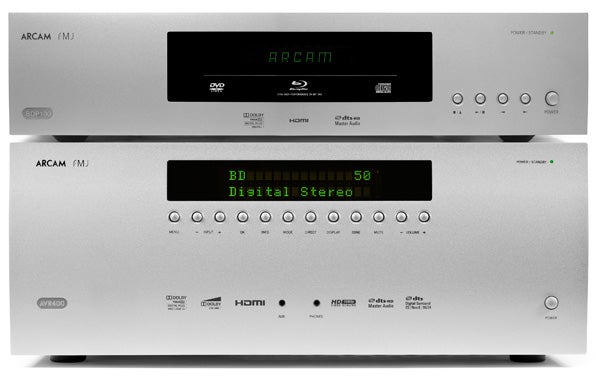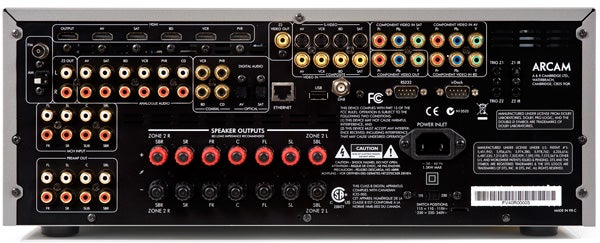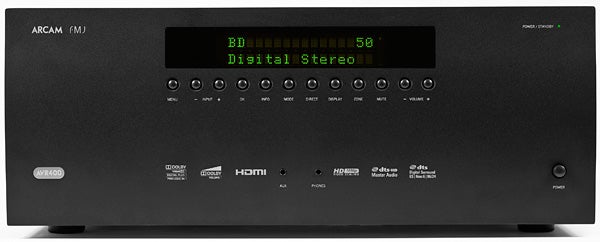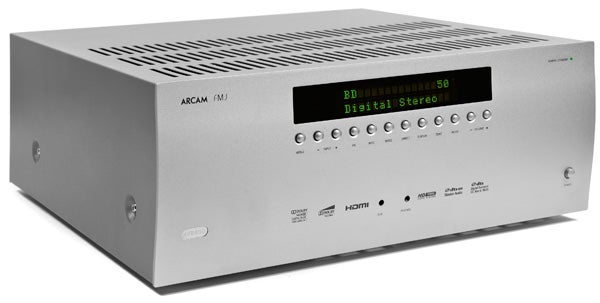Arcam BDP100 and AVR400 Review
Arcam BDP100 and AVR400
A Blu-ray player and AV receiver pairing for movie and music connoisseurs with big budgets.

Verdict
Pros
- Exceptional picture and sound quality
- Rock solid build quality and stunning looks
- Networking and Internet radio support (AVR400)
Cons
- No multichannel analogue outputs (BDP100)
- No 3D or networking support (BDP100)
- Slow disc loading and operational foibles (BDP100)
Key Specifications
- High-quality build quality and electronics
- BD-Live support (BDP100)
- Dolby True HD and DTS HD Master Audio support
- Torino video processing (AVR400)
- USB ports with digital media playback
”’Review based on the following prices:”’
BDP100: £999.00 (inc VAT) – www.hificorner.co.uk
AVR400: £1,699.00 (inc VAT) – www.hifigear.co.uk
Revered UK manufacturer Arcam has a reputation for putting performance first, regardless of how pricey the end product. This high-end Blu-ray player and AV receiver pairing continues in that tradition, boasting a sensational spec with the potential to send audio and videophiles to home cinema heaven. The BDP100 is Arcam’s first ever Blu-ray player, coming some ten years after the company launched its first DVD player, while the AV400 is the company’s latest ‘entry-level’ receiver, a 7.1-channel design that offers 90W per channel and features tech filtered down from the company’s AVR600 and AVR888.
The two are designed to work in tandem, not only technologically but also aesthetically. Both components are beautifully styled in a matching black or silver finish, and blend seamlessly when stacked on top of each other. Thankfully, they’re not plastered in buttons and flashing lights – their clutter-free fascias give off an esoteric, sophisticated air. The BDP100 features a single row of bullet-like buttons for up-close playback control and a large green-lit LED display. 
It’s mirrored on the AVR400 with a large display panel – which gives the full name of the audio format, volume level and input – and a tidy row of 12 buttons for input switching, sound mode selection and menu controls. Volume is controlled using two of these keys, which are less satisfying than a dial but visually much cleaner. You also get two inputs on the front – one of these is a multi-purpose 3.5mm aux jack, acting as an input for line-level analogue audio, digital audio (optical) and the supplied setup microphone. The other is a headphone jack.
As you’d expect at this price, build quality is incredible, which can only mean good things from a performance perspective. The BDP100’s inert chassis and damped cover aim to reduce performance-harming microphonic vibration, and at 100mm high it’s chunkier than your average Blu-ray deck, although high-grade AV circuitry of the type used here needs room to breathe.
These internal electronics have been carefully arranged to avoid cross-chassis interference – there are discreet sub-regulated power supplies for the drive, audio and DAC boards, while Arcam’s unique ‘Mask of Silence’ shielding techniques protect key signal paths from meddlesome radio frequencies.
Arcam also likens the player’s CD performance to that of an audiophile CD player, as it counts a Wolfson 8741 audio DAC and a linear-phase Bessel output filter among its audio electronics.
The AVR400 boasts similarly heavyweight bodywork, and on the inside there’s a heavyweight toroidal transformer, multiple power supplies for the internal building blocks and a multichannel Class A/B power amp that’s been optimised for low distortion.
The BDP100’s connections disappoint at this price. There are no multichannel analogue outputs, which are arguably more relevant on audiophile products like this, and the HDMI output is v1.3, which means there’s no possibility of 3D support for those whose want it.
However you do get component and composite video outputs, two analogue stereo outputs, plus optical and coaxial digital audio outputs. Custom install needs are catered for with the RS232, remote input and 12V trigger ports, a USB port is provided for BD Live storage and digital media playback, while the Ethernet port is your gateway to BD Live downloads. Sadly it’s not used for media streaming over a network, but that’s not a problem if you buy it with the AVR400, as the amp supports network streaming and internet radio via Ethernet.
The back of the AVR400 is teeming with connections. You get five HDMI inputs – all v1.4 specified and ready to handle audio from a TV (via the Audio Return Channel) and 3D, should you decide to pair it with a 3D-ready deck instead of the BDP100. These are joined by three sets of component video inputs, composite and S-video inputs (four each), a set of multichannel analogue audio inputs and pre-outs (both 7.1-channels), six digital audio inputs (four coaxial, two optical) and six sets of analogue stereo inputs. Outputs include composite, component video and Zone 2 analogue stereo, while the comprehensive line up of control, radio and network ports includes Ethernet, USB, DAB, FM and AM aerial inputs, RS232, rLead/irDock (Arcam’s proprietary iPod accessories), IR and trigger connections. 
The BDP100 is not a feature-packed Blu-ray player by any stretch of the imagination, but that’s by design – Arcam instead ploughed the money into high-class performance and weapons-grade build quality and had no intention of making the BDP100 do tricks like DLNA media streaming, internet video streaming or 3D playback. But that implies that all high-end buyers have no interest in these features, which probably isn’t true – many would love to have the option at this price. That said, Arcam has suggested that it will launch a 3D upgrade sometime this year.
It’s also surprising not to find the BDP100 playing DVD-Audio or SACD, but again that wasn’t part of Arcam’s game plan – the focus here is purely and simply on delivering the best-possible Blu-ray pictures and audio playback from a single unit.
Still, that’s not to say it’s completely devoid of frills. Its USB port can be used to play back media files from storage devices, and supported formats include MP3, WMA, JPEG, AVI and WMV, although it didn’t like our hi-def AVI files. It decodes Dolby True HD and DTS HD Master Audio too (helpful if you’re pairing it with a legacy amp that won’t decode those formats) and outputs in film-friendly 1080/24p.
The AVR400 is much more generous in the features department. In terms of core audio duties it supports every HD audio format as well as DTS ES, Neo:6, 96/24, Dolby Pro Logic IIx and Dolby Volume automatic levelling. But among the more exotic stuff is a high-powered Torino video processor, which provides cross input conversion and upscaling to 1080p, with range of adjustments including brightness, contrast, colour, edge enhancement and noise reduction. You can also use the AVR400 as a network client and stream media files via Ethernet from connected PCs running uPnP software. It supports MP3, WMA, WAV, FLAC and MPEG-4 AAC, a selection that will keep music fans very happy indeed, and the same files can be played from USB devices connected to the rear port.
Elsewhere, there are built-in DAB, FM and AM radio tuners, and when connected to your router you can manually browse for internet radio stations or use the vTuner service to organise them into favourites.
Just because the BDP100 and AVR400 are aimed at enthusiasts, it doesn’t mean their operating systems should be impenetrable. So it’s pleasing to discover that both units are very easy to install and operate. Most surprising is that the AVR400 has a built-in automatic speaker setup system, which isn’t something you’d necessarily expect to find on such a high-end receiver. Simply connect the setup mic to the front port and the AVR400 will make the crucial speaker settings for you, and adjust the EQ values to suit the acoustics of your room.
The BDP100’s onscreen menu system looks rather familiar having been used on a couple of Marantz’s recent products. That’s no bad thing though, as it’s a logical system that progresses from left to right in concentric arcs and uses eye-catching icons, jazzy colours and legible text. Finding and playing content from USB sticks is easy, breaking it down into ‘Music’ and ‘Video’ menu options. On the downside it’s a little sluggish at times and the process is complicated slightly by the presence of a Playlist feature – several times I accidentally added something to the playlist when I just wanted to play it. 
The AVR400 also has its own onscreen menu system, which is completely different to that of the BDP100. It’s a more basic affair, using plain boxes and primary colours, but no less easy to use. It fills the screen and packs in a comprehensive array of options – we’d be here all day talking you through it all. Rest assured that you can manually tweak the speaker settings down to the finest detail, and easily configure the AV connections.
The remotes supplied with both of these units are virtually the same, and look gorgeous in their light silver finish. You can use one to control both components – in fact both zappers are learning universal remotes and can be setup to control up to eight AV devices with a built-in library of codes or by programming them with your original remotes. That said, the button placement isn’t particularly intuitive, with the playback keys all jumbled up at the bottom and dual-function labelling making the search for certain functions a bit of a chore.
Onto performance and we started by checking out the BDP100’s disc-loading speed, which Arcam claims has been optimised to make it ‘as fast as possible’. Sadly that wasn’t the case in our benchmark ”Terminator Salvation” test, with the Arcam taking one minute and five seconds to get from hitting close on the disc tray to playing the first moving image – the fastest players are currently clocking in at around 40 seconds. To be fair, other discs will load much more quickly than that.
For picture quality we move to ”The Dark Knight”, and the only word to describe the BDP100’s picture quality is ‘wow’. The subtlety, depth and searing sharpness with which it conveys the disc’s 1080p pictures is mesmerising. Gotham City’s dark, dingy streets look clear and intricately detailed; there’s beautiful differentiation between the various shades of black in Batman’s costume; bright colours are not only natural and richly saturated but also enjoy smooth, nuanced shading; and fine textures, like The Joker’s smudged, pockmarked skin, look crisp and poised with no digital noise buzzing around inside.
We also gave it a whirl with Silicon Optix’s HQV disc and its performance is flawless. It instantly locks on to the cadences of the Film and Video Resolution Loss tests, renders moving diagonals without a single jaggie, and reproduces the camera pan across Raymond James stadium with a smoothness and confidence that borders on arrogance.
It should be said, however, that while its pictures are clearly superior to most budget decks, with others the differences are marginal. For example, Panasonic’s DMP-BDT310 delivers pictures that look just as good for a fraction of the price.
The AVR400’s sound quality is similarly dazzling. With the vehicle chase scene in ”The Dark Knight”, it brings cinema-scale sound into your living room, reproducing the bangs, crashes and gunshots with relentless drive and punch. Its reach is expansive, showering the room in gloriously crisp and brilliantly timed effects.
There’s elegance to high-frequencies that you rarely hear on budget receivers, most clearly heard in the tinkling of shattering car windows, while at the other end of the spectrum bass tones sound potent and tightly fused to the other speakers – check out the bit where the Joker fires a bazooka for the proof. Voices are realistic and eminently audible too. This is a majestic performance that continues in the musical realm when you play CDs like Adele’s ”21” – the combination of crisp, sprightly treble, pure, wholesome vocal tones and taut bass is spine-tingling.
Verdict
For buyers with big budgets who want the very best pictures and – more crucially – the best sound quality possible from a Blu-ray player and receiver, then this pairing is a wise investment. Blu-ray images are sensational, but the biggest advantage over the hordes of budget decks on the market is its audio quality, which is every bit as good as an audiophile CD player, made possible by the sensational build quality and careful, interference-free arrangement of high-grade electronics.
But on the downside, the BDP100 is seriously light on features for £1k. There’s no 3D compatibility (yet) and none of the web-enabled features so common in the budget sector. This may not necessarily be a concern for some movie enthusiasts, but others may expect more when splashing out this sort of money.
However, if you’re buying it together with the AVR400, it’s not so much of a problem – this powerful receiver boasts an excellent feature list, including network media streaming, DAB and Internet radio access and loads of connections. What’s more the two components together look stunning and deliver exciting, sophisticated sound quality.
Trusted Score
Score in detail
-
Performance 10
-
Design 10
-
Features 7
-
Value 8

